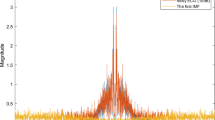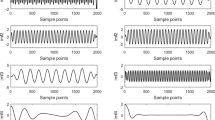Abstract
A joint empirical mode decomposition and optimal frequency band estimation approach is proposed to reduce the low-frequency noise adaptively. In each level of the decomposition, this paper considers the residue as the approximation of the low-frequency noise while the sum of the intrinsic mode functions is considered as the approximation of the denoised signal. Conventionally, the signal-to-noise ratio (SNR) of the denoised signal is used as a criterion for determining the optimal level of the decomposition. In particular, the level of the decomposition which achieves the highest SNR is defined as the optimal level of the decomposition. However, as the clean signal is unknown, it is difficult to find the optimal level of decomposition. To address this issue, the cutoff frequency of the residue in each level of the decomposition is estimated via an optimization problem. Here, the total energy of the difference between the energy spectrum of the residue and that of its corresponding matched filter is minimized subject to a constraint on the energy of the matched filter being equal to that of the residue. After finding the solution of the optimization problem for each level of the decomposition, the index corresponding to the global minimum of the absolute difference of the optimal cutoff frequency between two consecutive levels of the decomposition is defined as the optimal level of the decomposition. Since the optimal level of the decomposition is found automatically, our proposed method avoids the inappropriate selection of the parameter. Besides, the computer numerical simulation results show the superior performance yielded by our proposed method over the existing approaches on various test signals at different noise levels.











Similar content being viewed by others
Data availability
All the ECGs, the speeches and noises used in this paper are downloaded from the following databases: (1) https://archive.physionet.org/cgi-bin/atm/ATM. (2) http://spib.linse.ufsc.br/noise.html. (3) https://catalog.ldc.upenn.edu/LDC93S1
References
A.Y. Ayenu-Prah, N.O. Attoh-Okine, A criterion for selecting relevant intrinsic mode functions in empirical mode decomposition. Adv. Adapt. Data Anal. 2(1), 1–24 (2010)
S. Boda, M. Mahadevappa, P.K. Dutta, A hybrid method for removal of power line interference and baseline wander in ECG signals using EMD and EWT. Biomed. Signal Process. Control 67, 102466 (2021)
A. Boudraa, J. Cexus, EMD-based signal filtering. IEEE Trans. Instrum. Meas. 56(6), 2196–2202 (2007)
N. Chatlani, J.J. Soraghan, EMD-based filtering (EMDF) of low-frequency noise for speech enhancement. IEEE Trans. Audio Speech Lang. Process. 20(4), 1158–1166 (2012)
P. Feng, B.W.K. Ling, Singular spectrum analysis-based hierarchical multiresolution analysis with exploitation of frequency selectivities of desirable grouped functions. Circuits Syst. Signal Process. 40, 2967–2981 (2021)
P. Flandrin, G. Rilling, P. Gonçalvés, Empirical mode decomposition as a filter bank. IEEE Signal Process Lett. 11(2), 112–114 (2004)
J. Garofolo, L. Lamel, W. Fisher, J. Fiscus, D. Pallett, N. Dahlgren, V. Zue, TIMIT acoustic-phonetic continuous speech corpus, in Linguist. Data Consortium, Philadelphia, PA, USA
N. Huang, Z. Shen, S. Long, M. Wu, H. Shih, Q. Zheng, N. Yen, C. Tung, H. Liu, The empirical mode decomposition and the Hilbert spectrum for nonlinear and nonstationary time series analysis. Proc. R. Soc. Lond. A: Math. Phys. Eng. Sci. 454, 903–995 (1998)
M. Kabir, C. Shahnaz, Denoising of ECG signals based on noise reduction algorithms in EMD and wavelet domains. Biomed. Signal Process. Control 7(5), 481–489 (2012)
A. Kizilkaya, M.D. Elbi, Different scenarios on denoising of signals in the intrinsic mode function selection framework. IETE J. Res. 62(5), 605–614 (2016)
T. Koc, Post-processing method for removing low-frequency bias in glottal inverse filtering. Electron. Lett. 51(1), 110–112 (2015)
A. Komaty, A. Boudraa, B. Augier, D. Daré-Emzivat, EMD-based filtering using similarity measure between probability density functions of IMFs. IEEE Trans. Instrum. Meas. 63(1), 27–34 (2014)
W. Kuang, B.W.-K. Ling, Z. Yang, Parameter free and reliable signal denoising based on constants obtained from IMFs of white Gaussian noise. Measurement 32, 48–56 (2014)
W. Kuang, S. Wang, Y. Lai, W.-K. Ling, Efficient and adaptive signal denoising based on multistage singular spectrum analysis. IEEE Trans. Instrum. Meas. 70, 1–20 (2021)
G. Li, S. M. Wali Ullah, B. Li, J. Lin, H. Wang, Baseline wander removal for ECG signals based on improved EMD, in 15th IEEE International Conference on Signal Processing, pp. 484–487 (2020)
P. Lin, W. Kuang, Y. Liu, Grouping and selecting singular spectrum analysis components for denoising via empirical mode decomposition approach. Circuits Syst. Signal Process. 38, 356–370 (2019)
A. Malhotra, A. Chintanpalli, A real time wavelet filtering for ECG baseline wandering removal, in International Conference on Artificial Intelligence and Signal Processing, AISP, pp. 1–5 (2020)
A. Mert, A. Akan, Detrended fluctuation analysis for empirical mode decomposition based denoising. Digital Signal Process. 32, 48–56 (2014)
Z. Sun, X. Wang, X. Wang, K. Sun, Q. Tan, Removal of baseline wander in ECG signals using singular spectrum analysis, in IEEE 9th International Conference on Electronics Information and Emergency Communication (ICEIEC), pp. 391–394 (2019)
P.D. Swamia, R. Sharmab, A. Jaina, D.K. Swamic, Speech enhancement by noise driven adaptation of perceptual scales and thresholds of continuous wavelet transform coefficients. Speech Commun. 21, 1–12 (2015)
R. F. von Borries, J. H. Pierluissi, H. Nazeran, Wavelet transform-based ECG baseline drift removal for body surface potential mapping, in 27th IEEE Engineering in Medicine and Biology Annual Conference, pp. 3891–3894 (2015)
X. Wang, S. Zhang, L. Zhu, S. Chen, H. Zhao, Research on anti-Narrowband AM jamming of Ultra-wideband impulse radio detection radar based on improved singular spectrum analysis. Measurement 188, 110386 (2022)
G. Yang, Y. Liu, Y. Wang, Z. Zhu, EMD interval thresholding denoising based on similarity measure to select relevant modes. Signal Process. 109, 95–109 (2015)
Z. Yao, Z. Wang, X. Liu, C. Wang, Z. Shang, An improved low-frequency noise reduction method in shock wave pressure measurement based on mode classification and recursion extraction. ISA Trans. 109, 315–326 (2021)
L. Zão, R. Coelho, P. Flandrin, Speech enhancement with EMD and hurst-based mode selection. IEEE/ACM Trans. Audio Speech Lang. Process. 22(5), 899–911 (2014)
Acknowledgements
This paper was supported partly by the National Natural Science Foundation of China (No. 62101130), the Guangdong Basic and Applied Basic Research Foundation (No. 2020A1515110289) and the Dongguan Sci-tech Commissioner Program (No.20201800500182).
Author information
Authors and Affiliations
Corresponding author
Ethics declarations
Conflict of interest
The authors declare that there is no conflict of interest.
Additional information
Publisher's Note
Springer Nature remains neutral with regard to jurisdictional claims in published maps and institutional affiliations.
Rights and permissions
Springer Nature or its licensor (e.g. a society or other partner) holds exclusive rights to this article under a publishing agreement with the author(s) or other rightsholder(s); author self-archiving of the accepted manuscript version of this article is solely governed by the terms of such publishing agreement and applicable law.
About this article
Cite this article
Kuang, W., Yang, P., Lai, Y. et al. Joint Empirical Mode Decomposition and Optimal Frequency Band Estimation for Adaptive Low-Frequency Noise Suppression. Circuits Syst Signal Process 42, 4170–4196 (2023). https://doi.org/10.1007/s00034-023-02309-2
Received:
Revised:
Accepted:
Published:
Issue Date:
DOI: https://doi.org/10.1007/s00034-023-02309-2




